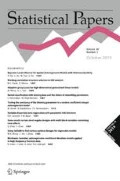Abstract
This paper is intended to consider a weighted proportional hazards model and the arising mixture model from it which is called weighted frailty model and study some properties in the context of reliability theory. It is shown that the frailty random variable and the population level variable are negatively likelihood ratio dependent. Closure properties of the model with respect to some stochastic orders and some aging classes of life distributions are investigated. Finally, preservation of some stochastic orders under the structure of the model is studied. Various illustrative examples are also given.
Similar content being viewed by others
References
Badía FG, Berrade MD, Campos CA (2002) Aging properties of the additive and proportional hazard mixing models. Reliab Eng Syst Saf 78:165–172
Barlow RE, Proschan F (1981) Statistical theory of reliability and life testing. Silver Spring, Maryland
Blazej P (2008) Preservation of classes of life distributions under weighting with a general weight function. Stat Probab Lett 78:3056–3061
Cha JH, Finkelstein M (2013) The failure rate dynamics in heterogeneous populations. Reliab Eng Syst Saf 112:120–128
Cha JH, Finkelstein M (2014) Some notes on unobserved parameters (frailties) in reliability modeling. Reliab Eng Syst Saf 123:99–103
Cox DR, Oakes D (1984) Analysis of survival data. Chapman & Hall, New York
Fernández-Ponce JM, Pellerey F, Rodríguez-Griñolo MR (2015) Some stochastic properties of conditionally dependent frailty models. Statistics 50(3):649–666
Gupta RC, Kirmani SNUA (2006) Stochastic comparisons in frailty models. J Stat Plan Inference 136:3647–3658
Gupta RC, Gupta RD (2009) General frailty model and stochastic orderings. J Stat Plan Inference 139:3277–3287
Gupta N, Dhariyal ID, Misra N (2011) Reliability under random operating environment: frailty models. J Comb Inf Syst Sci 36:117–133
Horny G (2009) Inference in mixed proportional hazard models with K random effects. Stat Pap 50:481–499
Jain K, Singh H, Bagai I (1989) Relations for reliability measures of weighted distributions. Commun Stat Theory Methods 18:4393–4412
Karlin S (1968) Total positivity. Stanford University Press, Redwood City
Kayid M, Ahmad IA (2004) On the mean inactivity time ordering with reliability applications. Reliab Eng Syst Saf 18:395–409
Kayid M, Izadkhah S, Zuo MJ (2015) Some results on the relative ordering of two frailty models. Stat Pap 1–15. doi:10.1007/s00362-015-0697-8
Kayid M, Izadkhah S, Mesfioui M (2016) Relative stochastic comparisons of additive frailty models. J Inequal Appl 2016(1):1–23
Kumar D, Klefsjö B (1994) Proportional hazards model: a review. Reliab Eng Syst Saf 44:177–188
Lai CD, Xie M (2006) Stochastic ageing and dependence for reliability. Springer, New York
Li X, Ling X, Li P (2009) A new stochastic order based upon Laplace transform with applications. J Stat Plan Inference 139:2624–2630
Li X, Da G, Zhao P (2012) Competing between two groups of individuals following frailty models. Methodol Comput Appl Probab 14:1033–1051
Luvalle MJ, Lefevre BG, Kannan S (2004) Design and analysis of accelerated tests for mission critical reliability. Chapman & Hall, New York
Marshall AW, Olkin I (2007) Life distributions. Springer, New York
Miller RG Jr (1981) Survival analysis. Wiley, New York
Misra N, Van Der Meulen EC (2003) On stochastic properties of m-spacings. J Stat Plan Inference 115:683–697
Misra N, Gupta N, Gupta RD (2009) Stochastic comparisons of multivariate frailty models. J Stat Plan Inference 139:2084–2090
Misra AK, Misra N (2012) Stochastic properties of conditionally independent mixture models. J Stat Plan Inference 142:1599–1607
Nanda AK, Bhattacharjee S, Alam SS (2007) Properties of aging intensity function. Stat Probab Lett 77:365–373
Nanda AK, Das S (2011) Dynamic proportional hazard rate and reversed hazard rate models. J Stat Plan Inference 141:2108–2119
Nelsen RB (2006) An introduction to copulas. Springer, New York
Newby M (1994) Perspective on weibull proportional-hazards models. IEEE Trans Reliab 43:217–223
Ortega EM (2009) A note on some functional relationships involving the mean inactivity time order. IEEE Trans Reliab 58:172–178
Patil GP, Rao CR (1978) Weighted distributions and size-biased sampling with applications to wildlife populations and human families. Biometrics 34:179–189
Patil GP (2002) Weighted distributions. Wiley, New Yrok
Rao CR (1965) On discrete distributions arising out of methods of ascertainment. Sankhy Ind J Stat Ser A 27:311–324
Scheaffer RL (2009) Size-biased sampling. Technometrics 14:635–644
Shaked M, Shanthikumar JG (1995) Hazard rate ordering of k-out-of-n systems. Stat Probab Lett 23:1–8
Shaked M, Shanthikumar JG (2007) Stochastic orders. Springer, New York
Vaupel JW, Manton KG, Stallard E (1979) The impact of heterogeneity in individual frailty on the dynamics of mortality. Demography 16:439–454
Xu M, Li X (2008) Negative dependence in frailty models. J Stat Plan Inference 138:1433–1441
Acknowledgments
The authors are grateful to two referees for their constructive comments which lead to the current improved version. The second author would like to extend his sincere appreciation to the Deanship of Scientific Research at King Saud University for funding this Research Group No. (RGP-1435-036).
Author information
Authors and Affiliations
Corresponding author
Rights and permissions
About this article
Cite this article
Jarrahiferiz, J., Kayid, M. & Izadkhah, S. Stochastic properties of a weighted frailty model. Stat Papers 60, 53–72 (2019). https://doi.org/10.1007/s00362-016-0826-z
Received:
Revised:
Published:
Issue Date:
DOI: https://doi.org/10.1007/s00362-016-0826-z



